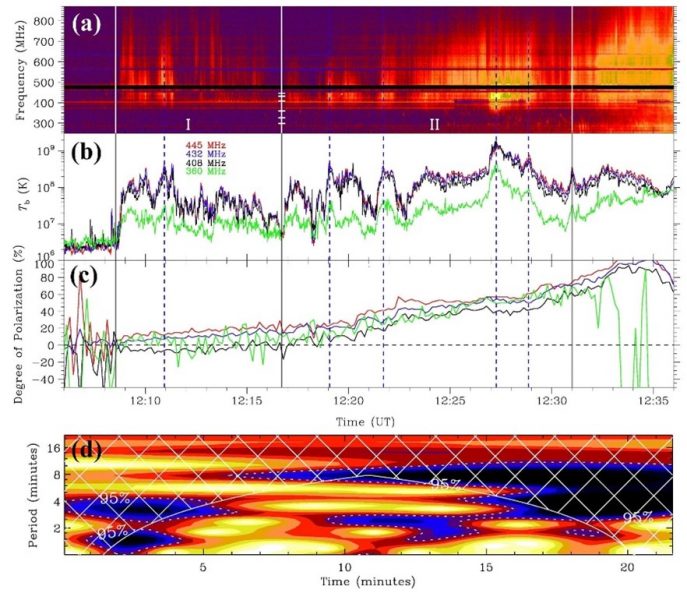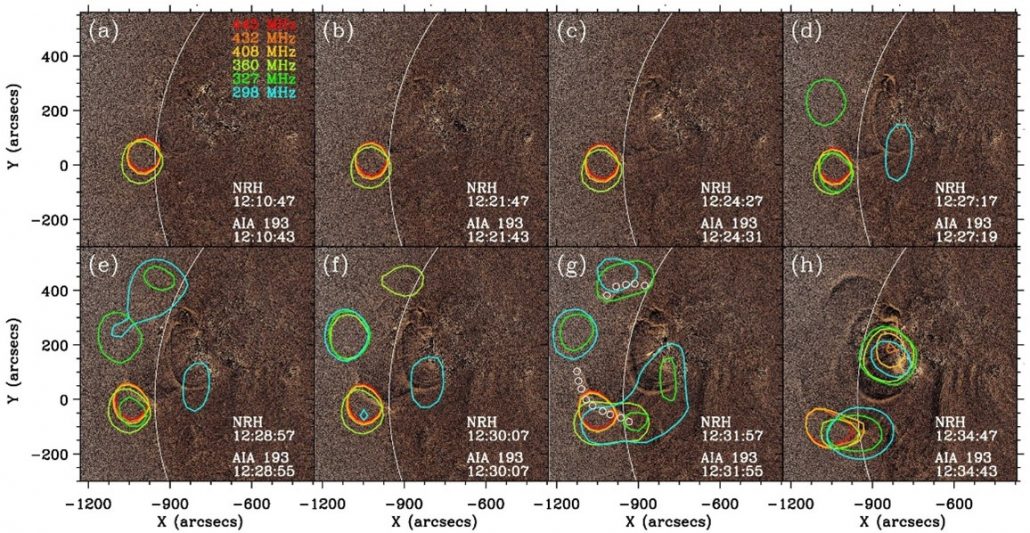Solar radio pulsations represent (quasi-)periodic or irregular short fluctuations observed from the radio flux curves or the dynamic spectra, in almost all wavelength ranges from metric to microwave (See the review by Nindos & Aurass 2007). They can be classified as broadband pulsations (BBPs) and narrowband pulsations (NBPs).
Most earlier studies have focused on pulsations taking place during the impulsive or decay phases of solar flares. During the preflare stage, the energy released is expected to be much weaker, thus the signatures can be easily missed. Yet, such signatures may contain critical information about the pre-cursor or trigger of the subsequent eruption.
We reported a group of BBPs observed in the decimetric-metric wavelengths, taking place during the preflare stage of a M7.1 flare dated on 2011 September 24. The event was observed by NRH at several imaging frequencies and by SDO/AIA at EUV passbands. Such a complete data set was reported for the first time for preflare decimetric-metirc BBPs. The purpose is to understand the process causing the preflare pulsations.

Figure 1. Overview of the preflare BBPs: (a) the dynamic spectra recorded by the Bleien station with a time resolution of 0.25s, (b) the temporal profiles of Tb and (c) the degree of polarization recorded by NRH at four frequencies (360, 408, 432, 445 MHz), (d) the power spectrum given by the wavelet analysis using the Tb data at 445 MHz.
The BBPs started ∼24 min before the flare onset, extending from < 360 to above 800 MHz with no discernible spectral drift (Figure 1a). The BBPs are intermittent in general, they become denser and stronger later, in accordance with the temporal profiles of the brightness temperature (Tb) obtained at the four NRH frequencies (Figure 1b). The polarization levels at the four NRH frequencies are close to each other, being weak during the first stage (stage I) and increasing up to ∼60% at the end of the latter stage (stage II) (Figure 1c). The result of the wavelet analysis shows several periodic components, among which the ∼ 3 min signal is the most significant (Figure 1d).

Figure 2. The running difference images obtained by AIA at 171 Å, superposed by the 50% contours of the NRH data at different frequencies. The white circles in panel (g) delineate the front of the steepening EUV wave.
During the BBPs, frequent EUV brightenings occur and several jets eject from the flare region towards the main radio source (Figure 2). This indicates the occurrence of intermittent magnetic reconnection during the preflare stage.
A high-temperature structure (observed in the 94 Å passband) starts to rise at the early stage of the BBPs. It drives an EUV wave structure. Both the EUV wave and the hot structure manifest similar dynamics of gradual-impulsive acceleration. During the second stage, the EUV wave accelerates up to ∼473 km s-1 with an obvious steepening shock-like signature.
The following observational conclusions can be drawn with a combined analysis of the EUV and radio data. (1) During the early stage (stage I) the BBP sources remain stationary while during the later stage (stage II) the sources move outward with the steepening/accelerating EUV wave. The major BBP source, together with the other two sources, are located around the EUV wave front (Figure 2). (2) The BBPs get intensified and the level of polarization starts to increase upon the emergence of the EUV wave.
These observations strongly indicate that the steepening EUV wave contributes to the acceleration of the BBP-emitting energetic electrons during the later stage, in addition to the low-lying reconnection process that may provide seed particles to the EUV wave. In other words, the BBPs and the change of their characteristics are caused by the combined action of the EUV wave and magnetic reconnection.
We suggest that during stage I the BBPs are radiated by energetic electrons that are released by the reconnection process taking place within the flare source region as evidenced by the jets and EUV brightenings, during stage II after the emergence of the EUV wave these energetic electrons are further processed by the steepening wave and the resultant BBP sources are carried outward by the EUV wave. In the meantime, the EUV wave sweeps a series of loop tops during its outward propagation. According to Kong et al. (2015, 2016), such a EUV (or shock)-wave-sweeping-loop-top process favors the acceleration of energetic particles since the loop tops serve as an efficient trapping agency within which particles can be processed by the steepening wave/shock-like structure for multiple times. The intensified pulsations during stage II are a natural result of this further wave processing, and the gradual increase of the polarization level can be caused by the gradual change of the overall magnetic field orientation within the loop tops that are swept by the EUV wave front.
Based on the recent paper by Lv M., Tan B., Zheng R., Wu Z., Wang B., Kong X., Chen Y., Imaging Preflare Broadband Pulsations in the Decimetric-metric wavelengths, APJ, 950, 2, DOI: https://doi.org/10.3847/1538-4357/accf92
References
Nindos, A., & Aurass, H.: 2007, in Lecture Notes in Physics, Berlin Springer Verlag, ed. K.-L. Klein & A. L. MacKinnon, Vol. 725, 251
Kong, X., Chen, Y., Guo, F. et al.: 2015, ApJ, 798, 81
Kong, X., Chen, Y., Guo, F., et al.: 2016, ApJ, 821, 32
